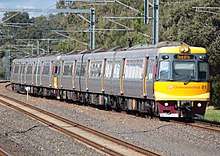Glossary of Australian railway terms
This page contains a list of jargon used to varying degrees by railfans, trainspotters, and railway employees in Australia, including nicknames for various locomotives and multiple units. Although not exhaustive, many of the entries in this list appear from time to time in specialist, rail-related publications. There may be significant regional variation in usage; state variances may be indicated by the state abbreviation (e.g. VIC, NSW).
B
- Bandicoot (QLD)
- An EMU with a distinctive grey band painted across the cab wind shields
- BETY
- QR pacific type BB18¼ 4-6-2 steam locomotive used on express passenger and freight trains—named after the telegraphic code
- Blue babies
- QR DD17 class suburban tank engine, in a blue midway between navy and sky blue
- Broad gauge
- 5 ft 3 in (1,600 mm) as used in the states of Victoria and South Australia. Standard gauge of 1,435 mm (4 ft 8 1⁄2 in) exists nationwide except for the state of Tasmania, Queensland runs some narrower 3 ft 6 in (1,067 mm) lines as do the states of West Australia and South Australia. The island state of Tasmania is exclusively 3 ft 6 in (1,067 mm).
- Brown bomber
- A QR C17 4-8-0 (2D) steam engine, typically painted brown
C
- Centralized traffic control (CTC)
- A system in which signals and switches for a given area of track are controlled from a centralized location[1]
- Conductor
- The person checking tickets on a tram or train
- Cyclops (QLD)
- An EMU with one cab modified to only have one central wind shield, which can then only be used as a guard's cab in the middle of a six-car set
D
- DERM
- Victorian diesel electric rail motor
- Detonator (DET) (Railway Track Signal)
- An explosive device placed on rail and triggered by wheel pressure—used to warn of hazard ahead
- Dog or dogspike
- A spike with a slightly altered head shape for easier extraction when the spike has become too loose in the sleeper[2][3]
- Doggies (VIC)
- Former "dog box" type red suburban trains
E
- Electric staff
- System of safeworking used on single track to allow the movement of trains
- Electric multiple unit (EMU) (QLD)
- A specific class of suburban train
- Evans set (QLD)
- Brisbane wooden suburban set
G
H
- Harris (VIC)
- Former Harris type (or Blue) electric suburban train
L
- Lamp
- A portable (often handheld) light source that is used to signal train crews[4]
- Light-headed guard
- See Battery-operated guard.
N
- Number nicker or number shark
- A rail fan who writes down numbers of trains they have seen
O
- OSCAR
- NSW TrainLink H set, a class of electric train operated in New South Wales[5]
P
- PawPaw
- QR class 1170 diesel
- Peg
- Colloquial term for train staff (token)
- Petrol electric rail motor (PERM)
- A railmotor operated by the Victorian Railways of Australia, later called the Diesel Electric Rail Motor
R
- Rail motor stopping place (RMSP)
- A short platform on a country line specifically for picking up and setting down of passengers of a rail motor
- Rattler (QLD)
- Colloquial term for former Evans sets in Brisbane
- Red Rattler (NSW)
- A colloquial term for the first-generation single-deck suburban trains from Sydney which operated from 1926 to 1993[6]
- Red Rattler (VIC)
- A slang term for a Tait train, a vintage suburban train from Melbourne
S
- Silver (VIC)
- Colloquial term for a Hitachi suburban electric trains
- Six-volt guard
- See Battery-operated guard.
- Snapper (QLD)
- Roaming staff who check tickets on trains or at stations
- Spark
- A suburban electric train
- Standard gauge (QLD)
- 3 ft 6 in (1,067 mm), as opposed to the 'broad' standard gauge used in other states
- Steel set
- QR suburban passenger sets from 1960s, replacing the Evans sets
- Stick
- Colloquial term for signal
- Sweat Set
- Colloquial term for Sydney Trains S sets
T
- Tait (VIC)
- Former Tait type (or Red) electric suburban train[7]
- Twix
- Two trains on the same mainline
- Tangara
- Sydney Trains T set, a class of electric suburban train in Sydney[6]
U
- Uniform gauge (QLD)
- Standard gauge
W
- White set
- A Queensland Railways long-distance train sporting their livery from the 1950s
- Waratah
- Sydney Trains A and B sets, also known as Waratahs[8][9]
See also
References
- ↑ "Railroading Glossary: C". TRN.Trains.com. Kalmbach Publishing. Archived from the original on 13 September 2014. Retrieved 20 February 2013.
- ↑ Railway Track Engineering (fourth ed.). New Delhi, India: Tata McGraw Hill Education Private Ltd. 2010 [first edition published 2000]. p. 122. ISBN 978-0-07-068012-8.
- ↑ Fitch, Ron J. (2006). Australian Railwayman: From Cadet Engineer to Railways Commissioner. Rosenberg Publishing Pty Ltd. ISBN 1-877058-48-3.
- ↑ Cunningham, William A. (1997). The Railroad Lantern, 1865 to 1930: The Evolution of the Railroad Hand Lantern as Reflected by the United States Patent Records and by Lanterns Made by Cross, Dane & Westlake, Dane, Westlake & Covert, the Adams & Westlake Manufacturing Co. & the Adams & Westlake Company. Wm. A. Cunningham.
- ↑ "The First Oscars are out and About". Sydney Trains. Retrieved 2 April 2018.
- 1 2 "Generations of Electric Rolling Stock". Sydney Trains. Retrieved 2 April 2018.
- ↑ Johnston, Susan (1990). "Tait, Sir Thomas James (1864 - 1940)". Australian Dictionary of Biography. Australian National University. Retrieved 12 October 2017.
- ↑ "Waratah Trains - Railway Technology". Railway Technology. Retrieved 2 April 2018.
- ↑ O'Sullivan, Matt (2018-03-22). "New Waratah Trains Finally Signal End to Sydney's 'Sweat Sets'". The Sydney Morning Herald. Retrieved 2 April 2018.
This article is issued from
Wikipedia.
The text is licensed under Creative Commons - Attribution - Sharealike.
Additional terms may apply for the media files.
